![]()
バンテアイ・スレイ(Banteay Srei/The Citadel of the Women)
通常、アンコール遺跡はその時代の王によって造られるのですが、バンテアイ・スレイは例外になり、967年にヤジュヌヴァラーハ(ラジェンドラバルマン2世からジャヤバルマン5世の時代)という王の師によって造られたヒンドゥー教寺院です。他の寺院に比べるとミニチュアのような小さな寺院ですが、驚きは内部に隠されています。
中央には3本の祀堂があるのですが、このうち中央の塔は男性の祖先に捧げて北と南の2本は女性に捧げて造られたと言われ、中央の塔の入り口には男性の守り神、残る2本には女神が刻まれています。この寺院は、当時稀少だった「赤色砂岩」で造られていて、パッと見た目にも他の寺院と違った印象を受けます。
残されたレリーフはインド文化の影響を感じさせるもので、どれも彫りが深く、ため息が出るほど綿密なものです。中でも、南北の塔に描かれた女神(別名、東洋のモナリザ)が秀逸です。
バンテアイ・スレイとは「女の砦(The Citadel of the Women)」を意味します。他に類を見ない、この美しい女神たちにちなんで、寺院自体がこの名で呼ばれるようになったのです。但し、現時点ではユネスコの指導により、東洋のモナリザを見ることはできません。(出典:
アンコール・エクスプローラーズ)
Banteay Srei means "Citadel of the Women." While some of the temples are impressive because of their sheer size, Banteay Srei stands alone in the quality of its construction and decoration. Its pink sandstone wall are decorated with what some consider to be the best carving of all and in an amazing state of preservation. Built in 967 and dedicated to Brahma it is located 25 kilometers North of Angkor Wat. (informed by Cambodia - Angkor Wat Travel Professional)
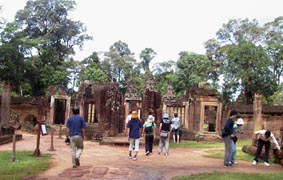 |
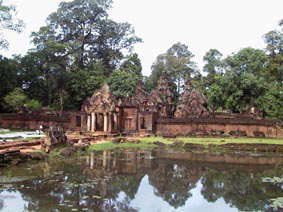 |
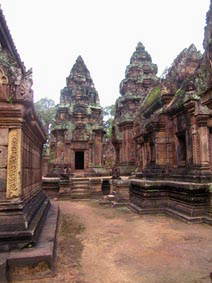 |
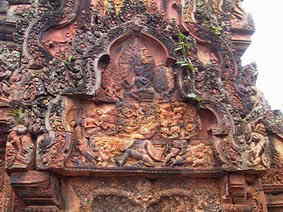 |
バンテアイ・スレイから北東へ15kmの場所にある小さな山の中に発見された遺跡です。川底や周囲の巨大な砂岩には巨大なヨニ(一辺が2m)、ヒンドゥーの神々などの様々な彫刻が残されています。特に勇名なのは「千本のリンガ(River
of 1000 Lingams)」、前述のプノン・クーレンのものとも表現方法が違い、上から見ると円形、横から見ると筒型になっており、あわせてみると立体的に見える仕組みになっています。
レリーフがある場所への道はアップ・ダウンが激しく一部の道は山登りのような状態。それをこなす自信のある人には必見の遺跡ですが、乾期には水が枯れてしまうことがあります。(出典:
アンコール・エクスプローラーズ)
The source of the Siem Riep River, which traverses the site of Angkor in Kampuchea, originates some forty kilometers north east of the Bayon, in the Kulen Mountains. At Kbal Spean, the river passes under a natural rock bridge, and over a waterfall, before continuing on past the exquisite temple of Banteay Srei, into the plain of Angkor. Kbal Spean means "bridge head." Alongside the bridge, Vishnu appears sculpted on a rock face, reclining to give birth to Brahma from a lotus growing out of his navel. On stone ledges of the river bed are innumerable grids of lingams, oriented to magnetic north, sculpted in bas-relief around the 9th century. The temples of Angkor follow an east west orientation. At the "River of 1000 Lingams," the source which irrigates and inseminates the plain of Angkor washes over, and is washed by its passage over these modulated surfaces. (informed by Vis Asia)
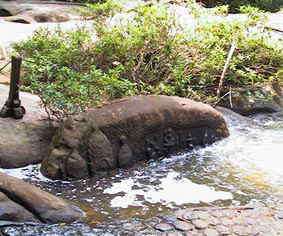 |
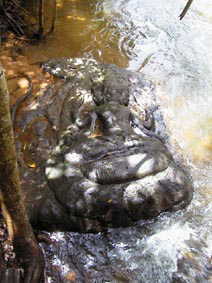 |
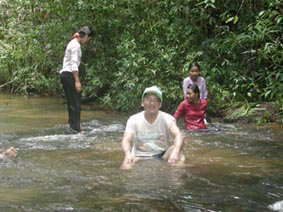 |
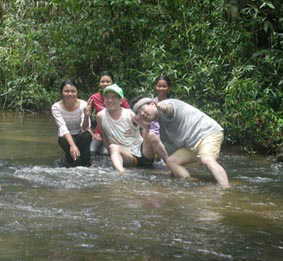 |
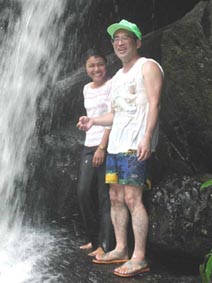 |
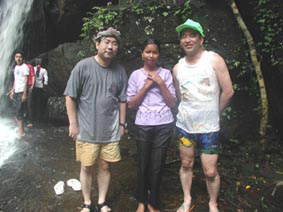 |